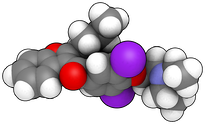Oregon Health and Science University (OHSU) recently received $245,115 in new NIH science research funding for a study of the effectiveness of two drugs commonly used to restore heart function in cardiac arrest victims. Researchers will be determining whether the drugs Amiodarone and Lidocaine actually improve cardiac arrest patients' chance of survival, and if so which is more effective. These drugs are both used to restore the loss of rhythmic and regular heartbeats that is a common cause of cardiac arrest, though their overall effectiveness at improving survival among patients has not been well documented. Typically first responders pick one or the other, but their decisions are not based on hard comparative evidence of the drugs' benefits.

 (3D visualization of Amiodarone and Lidocaine molecules)
(3D visualization of Amiodarone and Lidocaine molecules)
The drug effectiveness study will examine the effects of Amiodarone, Lidocaine or Placebo on emergency patients suffering from cardiac arrest. Called ALP for short, the research study is being carried out as part of the NIH-funded Resuscitation Outcomes Consortium (ROC). The consortium consists of 10 regional health organizations throughout the U.S. and Canada which focus on improving care for cardiac arrest and severe trauma patients through research and clinical trials.
ROC-ALPS will specifically be studying whether Amiodarone and Lidocaine, or no drug (a saline placebo), can help resuscitate patients with ventricular fibrillation, a prominent cause of cardiac arrest, which is resistant to shocks from a defibrillator to restore normal heartbeats. Ventricular fibrillation is a specific cardiac condition characterized by uncoordinated contraction of heart muscles. It is present in about 25% of cardiac arrests. The drugs will be administered by emergency medical technicians who will not know what is in the syringe they use.
 Mohamud Daya, associate professor of emergency medicine at OHSU and principal investigator in the study, summarized the importance of this research saying:
Mohamud Daya, associate professor of emergency medicine at OHSU and principal investigator in the study, summarized the importance of this research saying:
"During cardiac arrest, the heart stops functioning, and unless restarted within minutes, the patient typically dies. Treatments applied by paramedics and first responders at the scene are based on what's been successful in non-human models of resuscitation, hospital-based therapies and expert opinion. The only way to turn our 'best guess' treatments into a scientific approach is to study resuscitation treatments directly on individuals at the scene of the incident."
Dr. Daya's interest in emergency medical procedures and their efficacy is based on his very hands-on experience: He has been the medical director for the Portland Fire Bureau, as well as an ambulance company. Now he's the medical director for both Tualatin Valley Fire and Rescue and Forest Grove Fire and Rescue, advising them even as he works as an emergency-room physician at OHSU and a research scientist.
If you are a laboratory supplier or life science researcher in the Portland area, plan on attending Biotechnology Calendar Inc.'s Portland BioResearch Product Faire life science trade show event at OHSU on September 13, 2012. Our trade shows provide an opportunity for life science researchers to network with suppliers and keep up to date on the latest laboratory technologies in your field.
Receive more funding and research information on OHSU by clicking on the button below.


